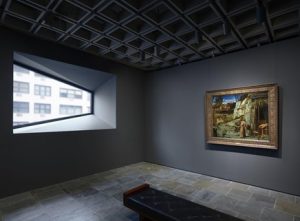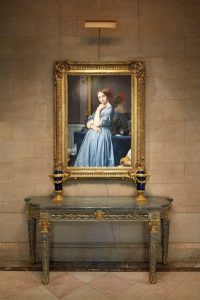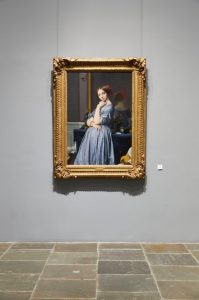by Angela Tillapaugh
The Frick Collection, located in New York City, is an art museum that houses paintings primarily by the Old Masters, as well as sculptures and decorative

arts. While the Frick’s original building, Henry Clay Frick’s Beaux Arts mansion, remains closed for renovations, they are showing a portion of their collection at the Marcel Breuer building on Madison Avenue. Even though the galleries of the Breuer building stand in stark contrast to those of the Frick mansion, all cool shades of gray and hard concrete to the mansion’s colorful walls and vibrant textiles, the curatorial staff has chosen to present the artworks similarly. That is, without object identification labels or wall texts. The Frick relies on other methods for conveying details about the art, including educational programs.
Cocktails with a Curator started on April 10th, 2020 after the museum closed to the public in response to the pandemic and streamed live each Friday at 5pm for over 60 weeks. After the completion of the livestream, videos are put on their YouTube channel. This series became immensely popular with the public, often receiving well over twenty thousand views, an improvement on a few hundred views on other videos. The Frick collected two awards for the Cocktails series, “Best Virtual and Remote Experience: Arts and Culture” from the Webby Awards and “Best Digital Exhibition or Online Education Program” from the Global Fine Arts Awards. As Cocktails with a Curator is ostensibly the Frick Collection’s best performing online program, what made this series so popular and caused it to resonate with audiences?
The structure of the videos is fairly simple. One of the two Frick curators presents the viewer with artwork from the permanent collection and a cocktail that they have chosen to pair with it. From there, the curator explains why they have chosen that beverage to pair with the artwork. Afterward, the curators give some historical background on the artist and the artwork; this includes details about when the Frick purchased the work, information about the artist and their body of work, and the purpose of the work. The curator then provides the viewer with a deeper analysis of the work, both from an artistic and socio-economic standpoint. As an example, we can look at the July 17th, 2020 video on Johannes Vermeer’s painting, “Officer and a Laughing Girl”. Curator Aimee Ng presents details of the painting and explains the way Vermeer uses paint to capture light. She also discusses the beaver skin hat the officer is wearing and the extensive damage that the beaver trade had on indigenous populations of North America. By providing this information Ng gives the audience a chance to understand the artwork as a whole, explaining both Vermeer’s painting techniques and the context in which he painted the work.

These videos certainly resonated with the target audience, the general public. I think there are a few reasons for this. First, the curators do not assume the audience has prior knowledge about art. They always provide definitions for specialized language and other details important to understanding the work. By doing so, they allow viewers to learn about art without getting frustrated by opaque language. They uploaded the videos to YouTube, making it easier to find and watch. If it was only accessible through a page on the museum’s website, it would have a higher chance of being lost to digital decay. The videos are relatively short, usually clocking in around 20-25 minutes. A curator could discuss the artworks for much longer, but many people do not want to commit an hour to watching a YouTube video on a topic that is a casual interest. Presenting information through the guise of a cocktail hour makes learning about art more inviting to viewers. A cocktail hour feels like being invited to an informal social event, not an intellectually rigorous lecture. The Frick provides the recipes in the description box for each video, so you could make the beverage ahead of time and join the curator in enjoying the drink.

I think it is important for the Frick to provide these friendly, close spaces for people to interact with art. The videos allowed viewers to learn about a work of art without the distraction of all the other items in the gallery, and with more detail than is provided in a Frick gallery. Additionally, the Frick Collection can seem intimidating to users, especially people who do not frequent art museums. In their original location, the artworks live in highly decorative rooms. The Gilded Age opulence can seem overwhelming and unapproachable. At the Madison location, the art is hung in sparse gray rooms that look cold and sterile. The Frick does not provide wall texts, and there are stricter rules for visiting that other museums do not have (they do not permit photographs, bags, or children under ten to enter). These elements combined can make visiting the Frick Collection daunting for visitors.
The online format appeals to people, and the Frick Collection appears to have understood what made the Cocktails with a Curator series popular with

viewers. They started a new series called Continuing the Conversation, which is a free event open to the public that occurs live over Zoom. This series of events, unlike Cocktails, invites attendees to join in the conversation. I think the Frick Collection has more work to do to make their museum more welcoming to those visiting in person, but the Cocktails with a Curator series certainly achieved its goal of getting viewers interested in their collections throughout their closure. Providing these comfortable spaces for people to engage with artwork online will likely have long term benefits for the Frick. The educational programs allow people to see past the less than genial galleries, and view the Frick as a place where they are truly welcome to visit and enjoy art.
